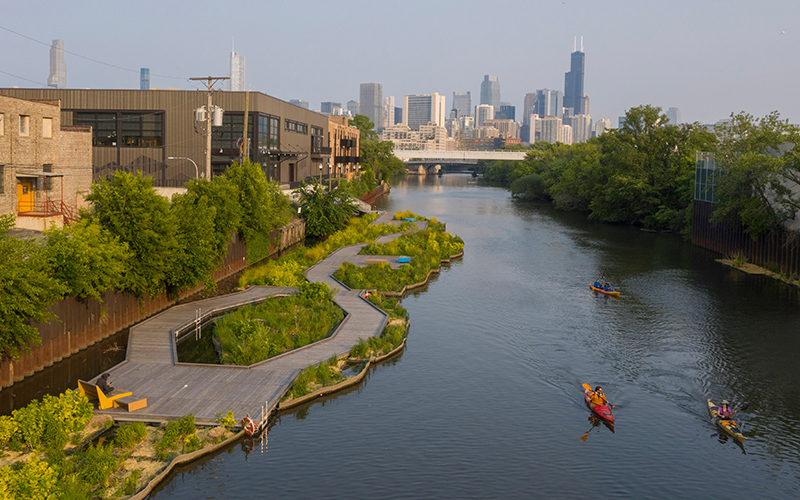 ASLA 2024 Professional Urban Design Honor Award. Wild Mile: Transforming an Urban River into a Floating Eco-Park. Chicago, Illinois. Greenprint Partners, Skidmore, Owings & Merrill / Scott Shigley
ASLA 2024 Professional Urban Design Honor Award. Wild Mile: Transforming an Urban River into a Floating Eco-Park. Chicago, Illinois. Greenprint Partners, Skidmore, Owings & Merrill / Scott Shigley
Washington, D.C., September 25 – The American Society of Landscape Architects (ASLA) and the ASLA Fund have released a free resource on how to design for biodiversity – Biodiversity Primer for Landscape Architects: Essential Knowledge to Inform Meaningful Action.
The resource was developed by the ASLA Climate & Biodiversity Action Committee (CBAC), a group of landscape architects charged with implementing key aspects of the upcoming ASLA Climate & Biodiversity Action Plan. Landscape architects play an important role in designing nature-based solutions that protect and increase biodiversity, reduce greenhouse gas emissions, and sequester carbon, enhance community resilience, and create economic opportunities.
“Having just returned from the International Federation of Landscape Architects’ conference spotlights for me how important it is that we share information and resources to achieve our mutual responsibility to our planet and each other. This primer brings together the latest global policy goals, science, and design best practices in one place,” said Kona A. Gray, FASLA, PLA, ASLA President. “It provides landscape architects with the baseline information needed to take action on the biodiversity crisis – the challenges we need to prioritize; the most effective ways to design solutions with ecologists, biologists, and others; how to measure our impact; and how to steward landscapes into the future.”
“The loss of biodiversity worldwide continues to accelerate. We need to rapidly shift to better ways of designing and managing landscapes and do our part to achieve global 2030 goals,” said Aida Curtis, FASLA, PLA, Chair, ASLA Climate & Biodiversity Action Committee and president, Curtis + Rogers Design Studio in Miami, Florida. “The primer introduces the real, concrete steps we can take on every project to protect, conserve, enhance, or restore healthy, enduring habitats for more species.”
The primer was edited by Betsy Peterson Sanford, ASLA, August Design Collaborative and co-chair of the CBAC Subcommittee on Biodiversity.
A team of CBAC biodiversity experts reviewed and contributed to the resource:
- Keith Bowers, FASLA, PLA, Biohabitats
- Lisa Casey, ASLA, StudioOutside
- David Cutter, FASLA, PLA, Cornell University
- Jennifer Dowdell, ASLA, Biohabitats
- MaFe Gonzalez, Assoc. ASLA, BASE Landscape Architecture
- Weston Henry, ASLA, SWA
- Maria Landoni, ASLA, Sur Landscape Architecture
- Meghan Mick, ASLA, PLA, Florida State University
- Christian Runge, ASLA, Mithun
- Grant Thompson, ASLA, PhD, PLA, RDG Planning & Design
The primer offers direction on how to mitigate the biodiversity crisis through design and planning work. It provides landscape architects with baseline information needed to support biodiversity through projects at all scales. It introduces foundational information that enables meaningful collaboration with allied fields, such as ecologists and biologists, during planning, design, and management phases.
The primer introduces a range of biodiversity topics, including:
- The state of the biodiversity crisis
- Global 2030 goals
- The five key biodiversity priorities
- How to design with landscape ecology principles
- How to design for biodiversity across scales
- How to measure impact, and
- How to steward a site for biodiversity
This resource supports the implementation of the ASLA Climate & Biodiversity Action Plan (2026-2030). It will be updated periodically to reflect the shifting state of nature, evolving global priorities, and the latest research.